It is that time when the sun has traveled back in the Northern Hemisphere, and summer is again upon us—this week marked the first whole week of summer. School is out and kids are on vacation. Families are planning for their summer cookouts, graduation celebrations, 4th of July festivities, and Pride Month joy is in the air. It is also the peak travel season when countries expect thousands of international tourists. Although there are new top destinations, such as Cancún, according to CNBC’s summer trend reports, European cities continue to be among the top summer destinations for many travelers. The Old Continent offers numerous opportunities to immerse oneself in meaningful experiences. Its rich history, vibrant art, stunning architecture, and lively nightlife help cities of the smallest continent amass 50% of international tourists.
One of its renowned attractions is the royal castles. However, because many flock to the most popular palaces, such as Versailles and Buckingham Palace, they often miss out on the hundreds of other European royal castles that offer unique experiences. If you dream of a European summer getaway that skips the tourist-packed landmarks and brings you closer to history, elegance, and peace, this list is your passport to magic. From the marvelous courtyards of Sweden to the sun-drenched terraces of Portugal, these crowdless attractions offer a majestic escape from the ordinary. This summer 2025 travel guide features 14 must-visit royal castles that are often overlooked—perfect for slow travel lovers and those chasing summer in Europe with a touch of enchantment. Before we dive in, let’s take a mini history lesson on European royalty.

European Royal History
When people think of royalty, especially European royalty, they often think of the British royal family as the most prominent royal family in the world today. However, there are 12 sovereign royal families in Europe. Among the 12 are seven kingdoms: the United Kingdom, Sweden, Norway, Belgium, Spain, Denmark, and the Netherlands. The remaining five include the three principalities, Monaco, Andorra, Liechtenstein, the Grand Duchy of Luxembourg, and the Vatican City, a theocratic elected monarchy with the Pope as its ruler. Although many of these states differ, numerous interconnections exist among them. Some of them, such as the UK, Denmark, Norway, Sweden, Spain, and Andorra, are successors of premodern states. Others, such as Liechtenstein, Belgium, Luxembourg, and the Netherlands, gained independence or established themselves during the Napoleonic Wars. Vatican City was established in 1929 as a sovereign state from the Italian Kingdom. Although 10 monarchies are hereditary, which means the line of succession is within the family, they are part of constitutional monarchies. Hence, they do not influence their government’s politics. They are figureheads, representing their government’s interests and diplomatic ties. The remaining two, Vatican City and Andorra, are elective monarchies, with the head of Andorra being the French President (who is elected by the French people) and the Count of Urgell, a county in Catalonia, Spain, who the Pope also elects.

Influence of Royal Attractions
Although the modern era has questioned the validity of royalty, many people are intrigued by them. They represent the history of human society, traditions, wars, the arts, and architecture. As apolitical figures, they help smooth diplomatic relations among nations, support humanitarian efforts through various charities, and make significant contributions to their countries’ tourism industries. Whether through TV or in person, royal events attract millions of spectators domestically and abroad. Among the European royal families, the British royal family has a greater reach than its counterparts. Research has shown that royal tourism has an impact on the UK economy. In 2017, the UK generated approximately £ 1.8 billion for the UK economy. Royal attractions, such as the private homes of the Prince and Princess or their official residences, like Buckingham Palace, are must-see destinations for many who travel to the UK. Museums with royal artifacts, such as jewelry, at the House of Jewels at the Tower of London are major tourist attractions. Millions worldwide watch royal events, including royal weddings, inaugurations, and the arrival of royal babies. The wedding of Prince William and Kate Middleton saw 23 million viewers in the U.S alone. Around 500,000 spectators flocked to the streets of London to wish the couple well, including international tourists. Some of whom travel specifically for the wedding. Although the other royal families do not attract as many international spectators as the British royal family during their events, other royal households still hold significant influence in their respective countries, with their palaces generating substantial tourism.
The popularity of royal castles is not limited to the remaining royal households. Other countries, such as France and Germany, which have abolished their monarchies, also see many advantages in tourism at their royal palaces. One of the most visited royal palaces is Versailles, which many regard as an architectural masterpiece. Other impressive palaces that tourists love to see are the Schönbrunn Palace in Austria and Neuschwanstein Castle in Bavaria, Germany. These royal attractions attract millions worldwide, and the high-peak season means it is sometimes hard to enjoy a day at these attractions. I visited Versailles in early June 2019, and the place was packed with various groups. From students’ visits for their end-of-year excursions and guided tours to many self-guided tourists like myself, enjoying the multiple rooms in Versailles proved challenging. I couldn’t take as many videos as I could because of the students’ program, and it is illegal to videotape people, especially young people, without their consent. Although the crowd in early June was not as packed as they would be during the hot summer peak, the restrictions of being with different groups made it a bit harder to enjoy. Hence, I understand travelers’ need to have crowdless attractions. Thus, this guide offers 14 European royal castles to enjoy for a crowdless and peaceful experience.

14 Must-Visit Royal Castles for a Peaceful European Summer Getaway
- Hohenwerfen Castle, Austria
When I think of royalty, I think of a majestic, cinderella-like castle set away from everyday view and surrounded by nature. When I think about spending time at a castle, I envision walking about the palaces, without bumping into anyone, and having the royal grounds to myself. Hohenwerfen Castle is a physical embodiment of what I consider a peaceful, crowd-free experience at a royal palace. Perched majestically on a rocky outcrop in the Salzach Valley of Austria, it offers a serene alternative to the crowded tourist hotspots. Unlike the more commercialized attractions, the medieval fortress invites visitors to step back in time, free from the bustle of large crowds. Built in the 11th century, Hohenwerfen is rich in history, featuring royal connections, religious significance, war, and Austrian military artifacts. The surroundings provide breathtaking panoramic views of the Austrian Alps and lush valleys.
Visitors can explore its well-preserved 900-year-old architecture, scenic viewpoints, and fascinating exhibitions about medieval life and weapons at a leisurely pace. Visiting this fortress takes you back to the Middle Ages with all five senses. Hohenwerfen Castle hosts various events throughout the year, including falconry shows and medieval markets, which are less crowded and offer an immersive experience. Summer visits to the castle include a movie showcase in the courtyard and children-friendly activities such as the children’s knight tournament. To satisfy your taste buds, the castle also offers a gastronomy experience where you can feast like the Knights. The tranquil atmosphere and the opportunity to connect with Austria’s rich history without the rush of tourists make Hohenwerfen an ideal destination for those seeking a peaceful retreat. It provides an authentic experience that is both enriching and rejuvenating. For a crowd-free experience, hike the forest trails early in the morning for a breeze-filled, nature-connecting experience.
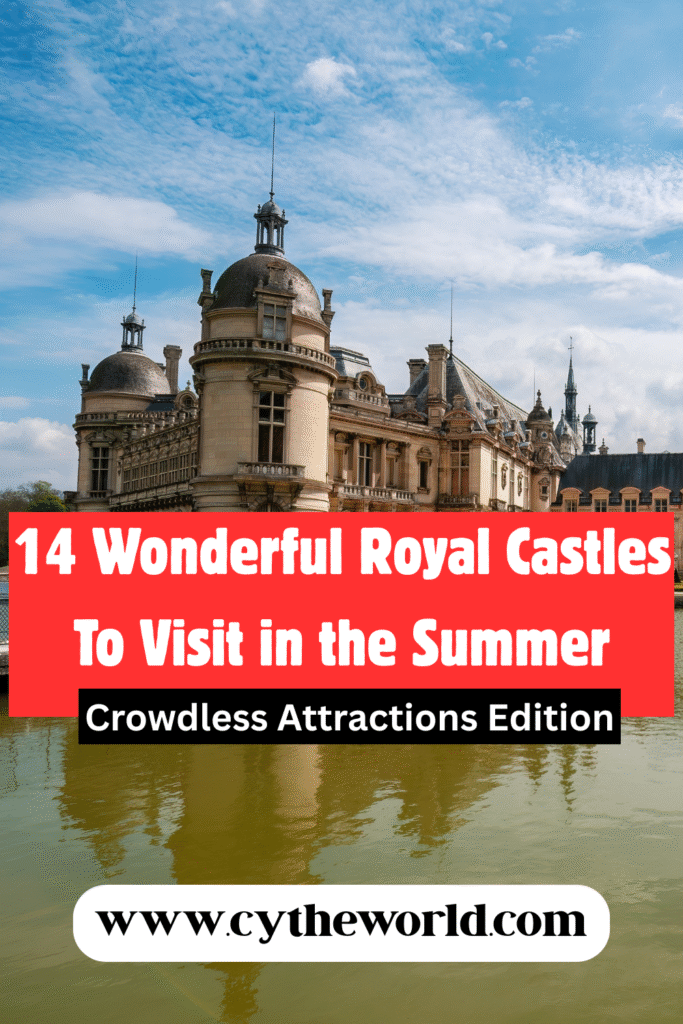
- Drottningholm Palace, Sweden
The second getaway takes us to Sweden. Although Sweden’s royal family does not generate as much buzz as its European counterparts, Sweden has one of the most impressive royal histories. The Swedish monarchy dates back over a thousand years, and the current king is the longest reigning monarch. With that extensive royal history comes historic monuments that tell the stories of its thousand-year-old existence. One of those historical statements is Drottningholm Palace. Located on the outskirts of Stockholm, it is a stunning blend of history and natural beauty. It is one of the most well-preserved royal castles built in the 1600s. Hence, it is a UNESCO World Heritage site. Although the southern wings are the permanent home of the current king and queen, the remainder of the palace is open to the public, giving them a chance to come close and personal with royalty. Its architecture encompasses elements of all of European architecture of that period. It reflects aspects of the French baroque style infused with Swedish tradition.
The palace also features the well-preserved eighteenth-century Chinese Pavilion and a charming theatre, which adds to its allure. What makes Drottningholm special is its serene surroundings and relatively tranquil atmosphere, which contrasts with the more crowded tourist attractions. The palace is situated on the shores of Lake Mälaren amidst beautifully landscaped gardens, creating an enchanting escape from the hustle and bustle of urban life. Visitors can wander the expansive grounds, meander along tree-lined paths, and enjoy the peaceful ambiance. The number of visitors is often limited, providing the perfect backdrop for quiet reflection and an intimate visit. You can picnic in the Nordic sun while taking in the natural landscape. Another way to add to your adventure is by taking a steamboat from Stockholm for a scenic ride. Drottningholm Palace offers a unique blend of history, culture, and nature, making it the perfect destination to explore in a serene, crowd-free environment. Hence, an excellent destination for a summer European getaway.
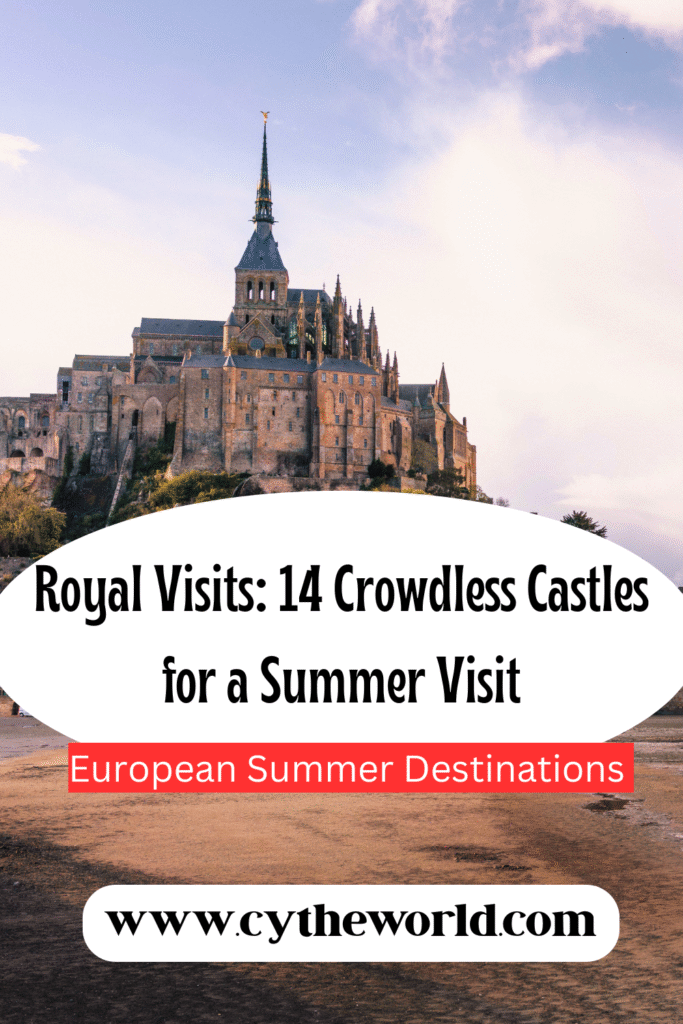
- Alcazar of Segovia, Spain
Like Sweden, Spain also has an extensive royal history that spans centuries. Spain once had 10,000 castles, but now it has about 2,500. One of its famous castles is the Alcazar of Segovia, a stunning castle in the picturesque city of Segovia, Spain. People say that the castle inspired Walt Disney’s emblematic Cinderella Castle. The castle is adorned with magnificent architectural features, including Mudejar-style elements, grand halls, and exquisite frescoes, which reflect the wealth and power of its royal inhabitants. Its unique shape, resembling the bow of a ship, adds to its allure, setting it apart from other castles in the region. It was initially built as a fortress during the Roman era, has witnessed centuries of transformation, and served various purposes, including a royal palace and a military stronghold. Throughout its history, the Alcazar has been associated with several Spanish monarchs, particularly the Castilian kings. It was one of the favored residences of King Alfonso X, and later, during the reign of the Catholic Monarchs, Ferdinand and Isabella, it became a key site in the royal court. Visiting the castle invites you to a remarkable monument rich in history and royal connections. It allows travelers to immerse themselves in medieval history while enjoying breathtaking views of the surrounding countryside.
Although it is among the most visited monuments in Spain, it has fewer tourist footprints than its counterpart, allowing visitors to experience its grandeur in a crowdless setting. Another reason a trip to the Alcazar of Segovia provides a peaceful experience is its landscape. It is surrounded by greenery and towers over a lake, offering a scenic view to indulge in and relax. Standing on the balcony offers a different view of the enchanting city. The city itself provides the perfect backdrop to a relaxing adventure. The city is a UNESCO World Heritage Site, featuring grand mansions, an old Jewish quarter, and the aqueduct, the largest in the Roman world. Spending a day in Seville, with the Alcázar as a must-see royal attraction, ensures one of the most peaceful and immersive experiences travelers can have in this ancient city. The combination of its architectural splendor, deep historical roots, and scenic location makes it a must-visit site for anyone exploring Spain’s rich heritage. The castle encapsulates the essence of Spanish royalty and offers a captivating glimpse into the past, making it a must-visit royal destination for a summer getaway to Europe.
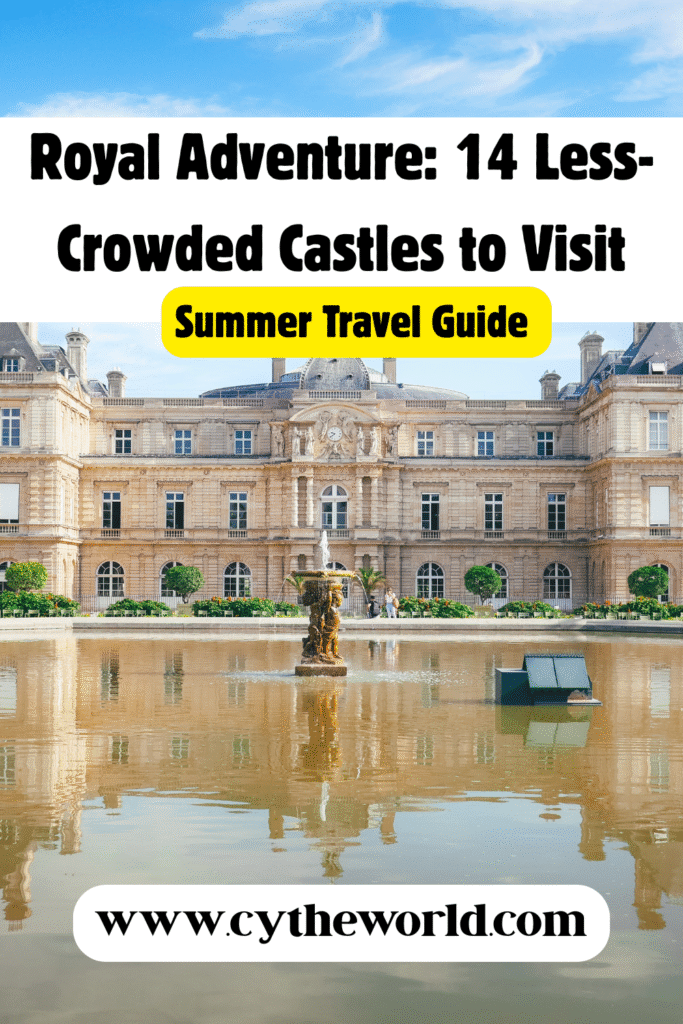
- Gaasbeek Castle, Belgium
The next Kingdom that holds many gems often overlooked is the Kingdom of Belgium. Although small, Belgium has a significant influence on international politics, art, culture, and culinary delights. The land that gave us waffles, French fries (or Belgian fries), and Tintin also has a tremendous royal history filled with fascinating events and scandals that put the British royal family’s scandals to shame. Moreover, it also boasts a variety of impressive royal castles that many people do not have the opportunity to discover. One of the most remarkable castles visitors to Belgium should not miss is the Gaasbeek Castle in Lennik, Belgium. This castle holds 800 years of history. Its current State is one of the many reincarnations of the castles that stood on its ground for 800 years. Its current architecture is a romantic interpretation of what people thought the Middle Ages looked like. Over the centuries, the castle served as a fort, refuge, and summer residence for various European nobility. Its last patron, Marquise Arconati Visconti, a woman famous for donating the art collection she inherited from her husband to the Louvre, donated this castle to the Belgian State in 1921, explicitly stating that the State use the castle as a museum and open it to the public. The Belgian State honored her last wishes in 1924, a year after her death, allowing visitors like you and me to indulge in this beautiful masterpiece.
Visiting Gaasbeek allows you to learn about Belgium’s history and the influences of other European nobility on the region. During your visit, you will experience all the castle has to offer. From enjoying the rich art collection to strolling through its beautiful green parks, Gaasbeek is a royal retreat that invites peace and imagination. It is a wonderful place to spend a day and get lost in its beauty and grandeur without worrying about overcrowded tourists. The castle also hosts various exhibits throughout the year, offering visitors an experience they won’t find elsewhere, set against the majestic castle backdrop. You can stroll around the gardens, take a short hike on the trails, and marvel at the largest beech trees in Belgium. The castle’s location, situated in the middle of the park, gives you the feeling of having the whole estate to yourself while basking in nature and enjoying a peaceful, quiet summer getaway, much like the aristocrats who once called this place home. Around the castle are the Saint Gertrude’s Chapel, the Triumphal Arch in honor of Napoleon, and many other attractions to complete your day visit. Hence, Gaasbeek Castle is a great royal attraction to add to your European summer getaway for a crowdless experience.
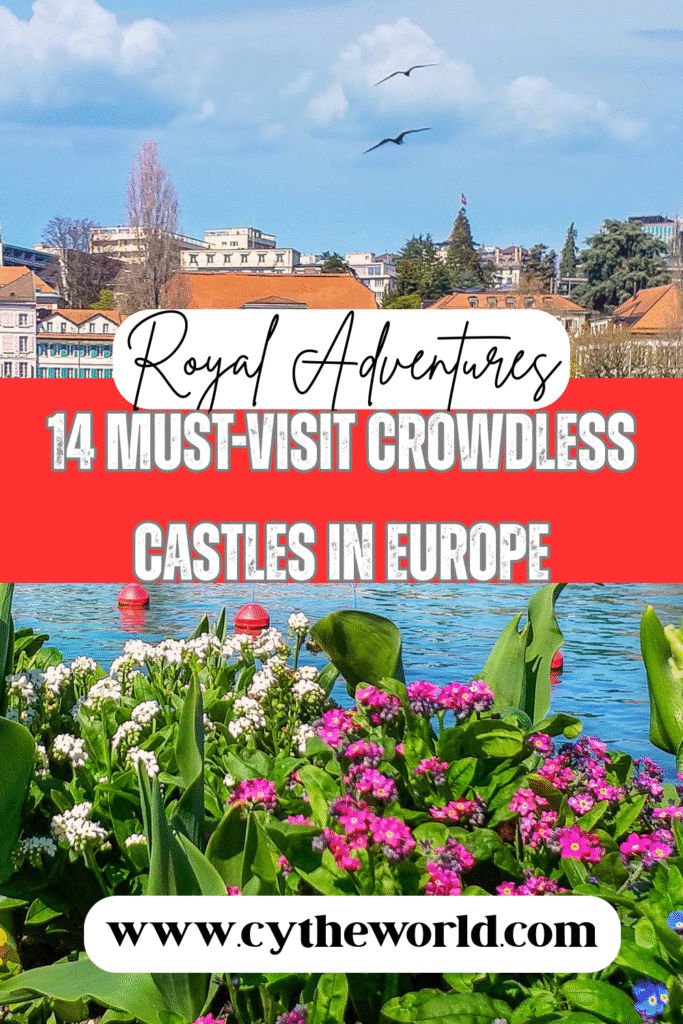
- Frederiksborg Castle, Denmark
If you are like me, you may have heard of the Danish royal family through the rom-com “The Prince and Me .” The movie became one of the reasons Denmark became on my travel wish list when I was a teenager. The Kingdom includes the Continental Denmark, the Faroe Islands, Greenland, and 1,400 other islands. 409 of the 1,400 islands have names, people inhabit 70, and others are just massive lands. Denmark has recently been in the international spotlight after President Trump stated he would like to purchase Greenland, a territory of the Kingdom of Denmark. Royal watchers would note that Denmark was also in the news because it is the latest Kingdom to have a recent coronation. In January 2024, King Frederik X became the new king, following his mother, Queen Margrethe II, who abdicated the throne in 2023. Denmark has an air of newness, inviting tourists to embark on its new era. With its thousands of islands, Scandinavia is home to many beautiful cities. Here are 10 places highlighted by the Independent newspaper. If you plan to visit the Scandinavian country and incorporate a royal visit, one castle you do not want to miss is Frederiksborg Castle.
Located north of Copenhagen in Hillerød, Denmark, Frederiksborg Castle is a remarkable testament to the nation’s royal history and architectural splendor. Built in the early 17th century by King Christian IV, the castle is an exquisite example of Renaissance architecture. Constructed as a royal residence, it showcases intricate designs, beautiful gardens, and a stunning lake that enhances its picturesque setting. The castle has witnessed significant historical events, including being the site of royal celebrations and a governance center. Today, Frederiksborg Castle is home to the National Museum of Denmark, which houses an impressive collection of portraits, historical artifacts, and exhibitions that detail Denmark’s past. One of the most significant advantages of visiting this enchanting site, particularly for those seeking a crowdless experience, is its expansive grounds and spacious interiors. Visitors can wander through the beautifully manicured gardens and roam the grand halls with tranquility, away from the hustle and bustle of more popular tourist spots. The serenity of Frederiksborg Castle provides an ideal backdrop for reflection and exploration as it is built across three lake islands, allowing visitors to immerse themselves in Denmark’s royal heritage at their own pace. Thus, it serves as a cultural landmark and a peaceful retreat for history enthusiasts seeking a more intimate experience. You can also rent a small rowboat for a castle view from the water.
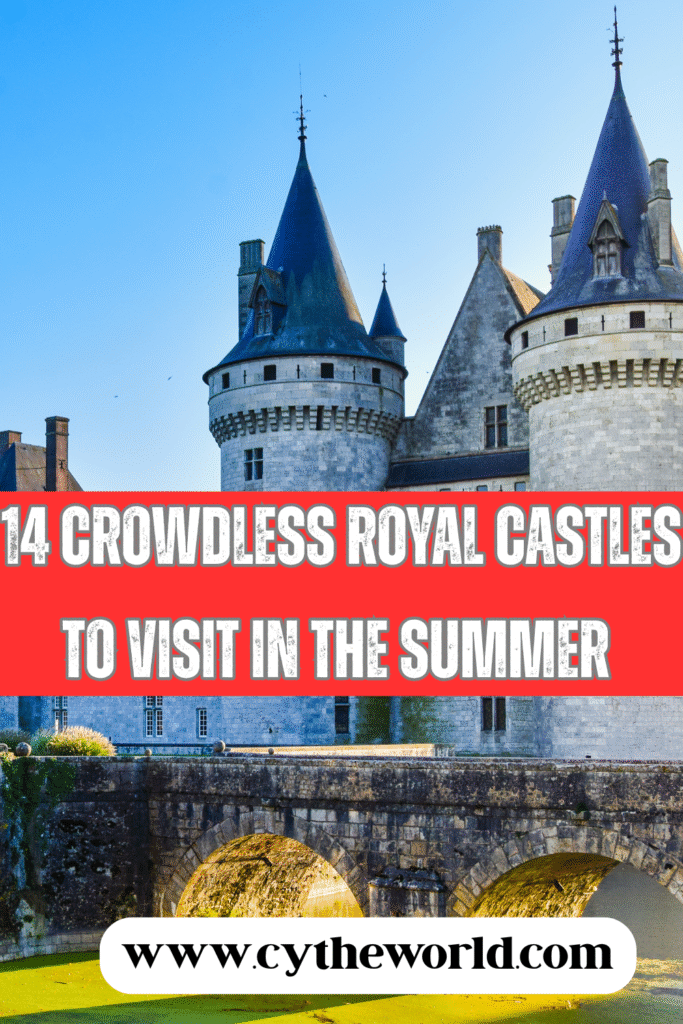
- Castello di Racconigi, Italy
Another European country that was once a monarchy is Italy. The modern Kingdom of Italy existed from 1861 to its dismantlement in 1946. However, the Italian monarchy has been around for centuries. Although the Italian government does not currently recognize hereditary nobility, the Italian royal family remains today. They do not represent the Italian government, unlike other royal families that are part of constitutional monarchies. However, among the Italian aristocracy, they still use their titles and participate in royal social events. To know more about the fall of the Italian Kingdom and their exile, there is a Netflix documentary called” The King Who Never Was.” The series covers a case that shook the Italian royal family while in exile in France. After 57 years in exile, the royal family was able to return to Italy in 2003. Although their influence is limited to their circle and the aristocracy, their palaces still serve as a testament to their presence in Italian history. One of the castles that reflects their existence is the Castello di Racconigi.
The Castello di Racconigi, located in the Piedmont region of Italy, is a remarkable example of royal architecture and a testament to the grandeur of the House of Savoy. Built in the 11th century, it evolved into a magnificent residence under the direction of various architects, notably including Pelagio Palagi. The castle served as a hunting lodge and summer residence for the royal family, embodying the opulence and cultural richness of the House of Savoy. It was also the center for life and events of the royals and their guests. Today, the Castello di Racconigi stands as a UNESCO World Heritage Site, captivating visitors with its extensive English-style grounds covering 200 hectares of land, beautiful gardens, and stunning interiors that reflect a bygone era. Its lesser-known status, compared to more prominent Italian landmarks, allows for a more intimate experience, making it ideal for those seeking a crowd-free escape. Unlike the bustling crowds at other tourist attractions, visitors can leisurely explore the castle’s vast grounds, indulge in its beautiful landscapes, and immerse themselves in the serene ambiance. The surrounding village in Piedmont serves as the perfect background to enjoy this castle without a hassle. The combination of historical significance, exquisite architecture, and the tranquility of its surroundings makes the Castello di Racconigi a unique destination.
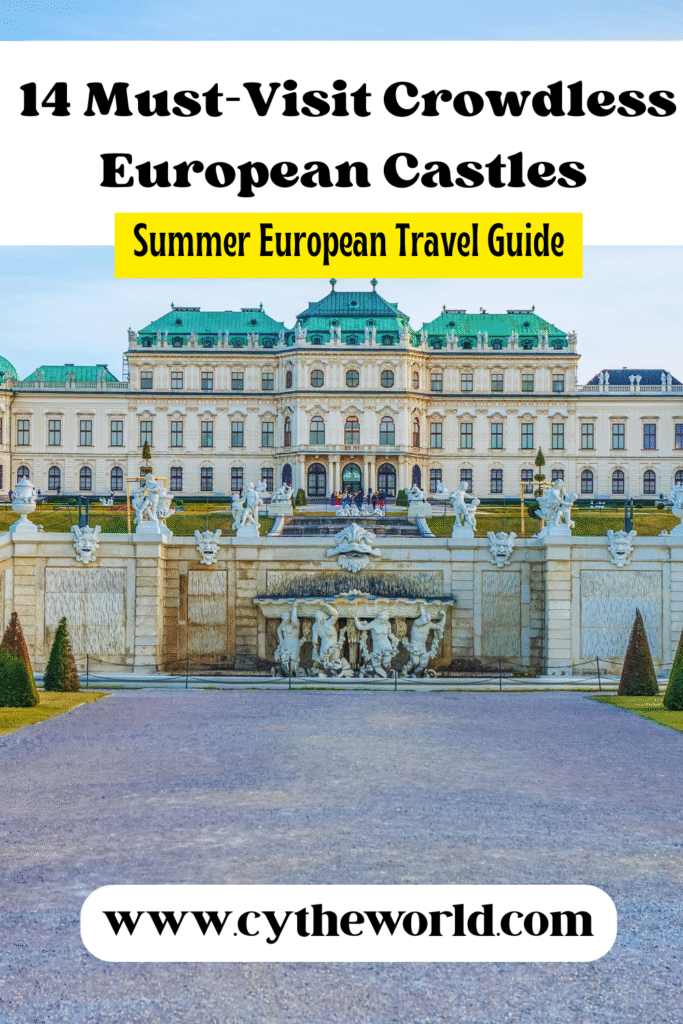
- Miramare Castle, Italy
For travelers who love a view of the ocean, a visit to Miramare Castle is a must. Perched on the cliffs overlooking the Gulf of Trieste in Italy, Miramare Castle is a breathtaking testament to 19th-century romanticism and a piece of history that attracts visitors worldwide. Unlike Castello di Racconigi, which is a testament to Italian royalty, Miramare is a testament to the Austrian Imperial family. Archduke Ferdinand Maximilian of Austria commissioned the construction in 1856 for his wife, Charlotte of Belgium. The ivory-white castle embodies a unique blend of architectural styles, including Gothic, medieval, and Renaissance elements, and is set against a picturesque backdrop of gardens. The castle’s rich history is intertwined with tales of ambition, love, and tragedy, as Maximilian later became the Emperor of Mexico, only to meet a tragic fate. Its historical backdrop adds depth to the visitor experience, allowing tourists to connect with the stories of the past. In addition to its historical significance, Miramare Castle is surrounded by serene gardens filled with exotic plants, manicured paths, and stunning sea views, offering a peaceful retreat from the loud and overcrowding of major tourist destinations The tranquil atmosphere, with the sound of waves and the scent of blooming flowers, makes it an ideal destination for relaxation and reflection. Visiting Miramare Castle allows tourists to explore a beautiful architectural marvel and immerse themselves in a tranquil environment, making it a memorable and rejuvenating experience. Visitors can enjoy a picnic at the seaside park and take in the sunset with this masterpiece as a backdrop.
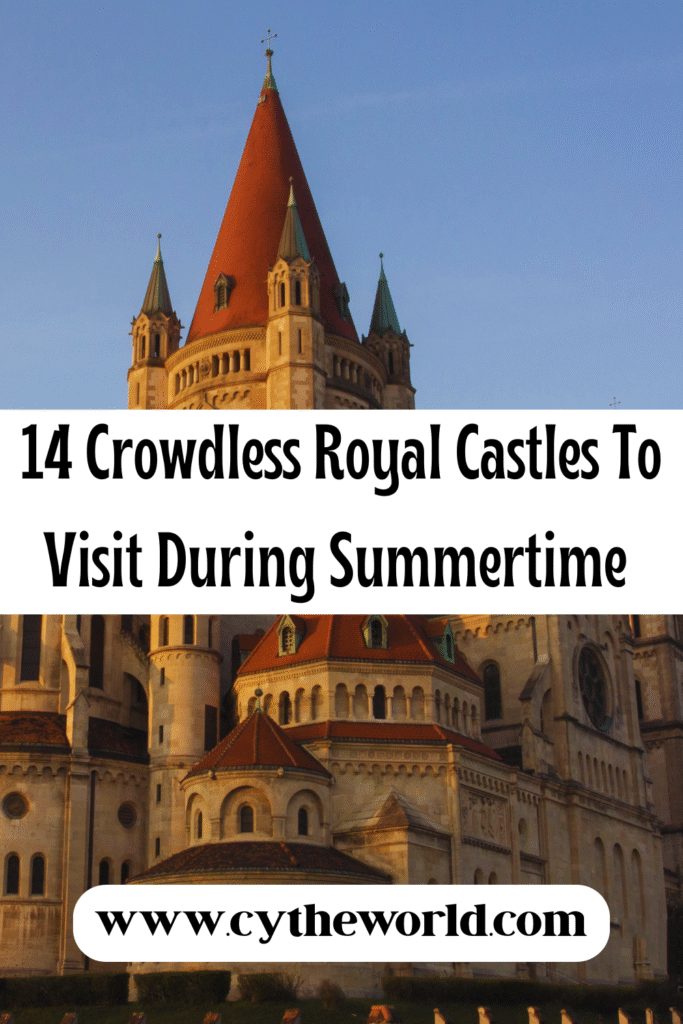
- Wawel Royal Castle, Poland
Poland is another European country that once had a monarchy. The early Polish monarchy was established in 1025, and the Third Partition of Poland dismantled its last monarchy in 1795. Although the central European country has not been a monarchy for 230 years, it has still preserved its royal collections, one of which is the Wawel Royal Castle. Perched on Wawel Hill in Kraków, Poland, Wawel Royal Castle stands as a testament to the country’s rich history and architectural grandeur. Like many castles on this list, Wawel is also a UNESCO World Heritage site, essential for tourism, and offers a unique glimpse into Poland’s royal past. The castle showcases a magnificent blend of Gothic, Renaissance, and Baroque styles, making it a visual feast for architecture enthusiasts. Visitors can explore the royal chambers, adorned with exquisite tapestries and art that reflect the opulence of Poland’s kings. Various exhibitions are open during the different summer months. In June, visitors can visit Castle II. The tickets include admission to the royal garden and artifacts from other locations, including the Ottoman Empire. From July to December, different areas of the castle will be open to the public, offering you a variety of experiences. Check out the website to see what will be available based on your visit date.
Adjacent to the castle is the Wawel Cathedral, which is equally stunning, boasting impressive tombs of Polish monarchs and offering the opportunity to ascend the Sigismund Bell Tower for panoramic views of Kraków. The cathedral served as a place of worship for the Polish kings for centuries, and most of them had their coronations there. Combining a visit to the castle with the castle gives you a complete experience of Polish royal history and life. To enjoy a crowdless experience, timing is key. Visiting early in the morning or on weekdays can help bypass the throngs of tourists. Visitors should also purchase tickets in advance online (they are free) to ensure a smoother entry process. Exploring the expansive castle grounds and the beautiful gardens at your own pace offers a serene ambiance, making it easier to absorb the historical significance. With its captivating history, stunning architecture, and the tranquil environment of its lavender-lined courtyards, Wawel Royal Castle promises an unforgettable experience for every traveler.

- Gödöllő Palace, Hungary
The Kingdom of Hungary is another kingdom that existed for thousands of years. Its royal history dates back to the year 1000 until its abolishment in 1946. In the 12th century, the Kingdom was a powerhouse in Europe. When the Ottoman Empire occupied the region, the kingdoms were divided into three parts: the Habsburg Royal Hungary, Ottoman Hungary, and the Principality of Transylvania. Both the Ottoman Hungary and the Principality of Transylvania were under Ottoman influence, whereas the Habsburg Royal Hungary became part of the Austrian Empire through the Habsburg royal family. The Kingdom of Hungary was a multi-ethic state. There are 10 countries today that derive from this Kingdom, and like the name suggests, Hungary is one of them. When visiting the Central European country, you will notice the castles that have stood for many centuries. There are approximately 100 castles in Hungary, serving as testaments to the country’s rich historical royal heritage. One royal castle that often gets overlooked is Gödöllő Palace.
Gödöllő Palace, located just 30 kilometers from Budapest, is renowned for its magnificent architecture and rich history. Built in the 18th century, it was initially designed as a baroque hunting lodge. The palace gained prominence when it became a favorite residence of Queen Elisabeth of Hungary, known as Sisi. She transformed it into a sumptuous retreat, where she found tranquility away from the court’s pressures. The palace reflects a blend of baroque and neoclassical architectural styles, featuring grand façades, opulent interiors, and expansive gardens that convey a sense of regal elegance. The surrounding area enhances the palace’s allure, featuring lush green landscapes and tranquil parks that are perfect for strolls. Visitors can enjoy the serene atmosphere, as Gödöllő is less crowded than other historical sites in Hungary. The palace’s spacious grounds offer ample opportunity to explore. Gödöllő Palace not only offers a glimpse into royal life but also serves as an ideal destination for those seeking a peaceful escape, just as its patron, Sisi, did. The combination of its historical significance, stunning architecture, and picturesque surroundings makes it a hidden gem, offering a crowdless experience that allows visitors to appreciate its beauty in relative solitude. During the summer evenings, tourists can enjoy classical concerts in the palace halls.
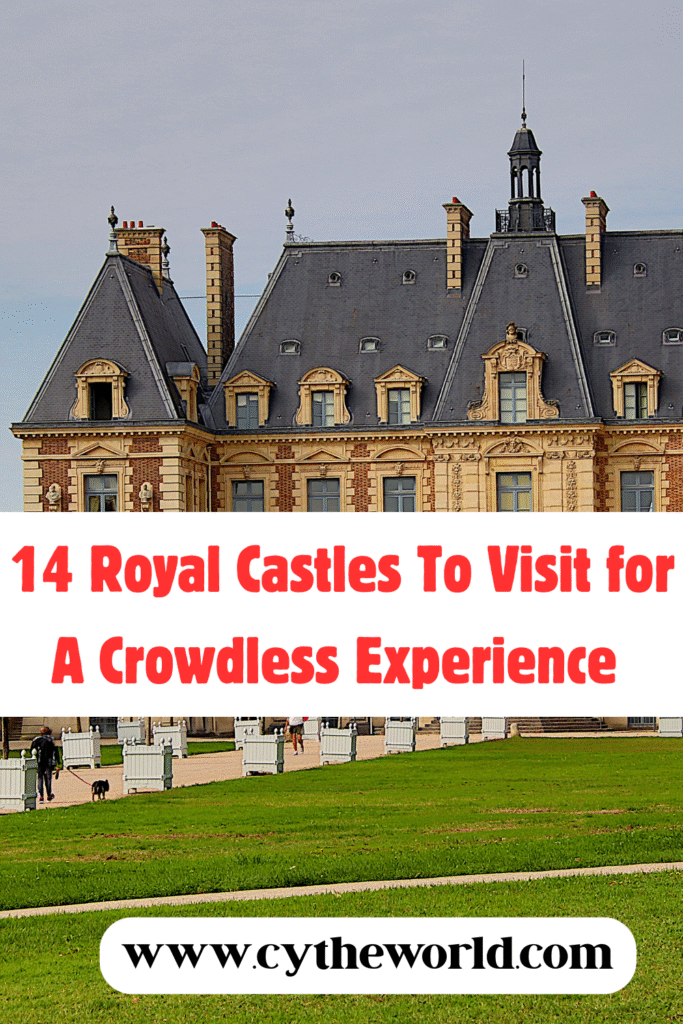
- Peleș Castle, Romania
The following country with a royal history is Romania. Unlike its counterparts, which have centuries of royal history, Romania’s royalty only existed for 66 years, from 1881 to 1947. Although short, the king ensured that he built monuments that would stand as testaments to this period of Romania’s history. One of the most important monuments for that period is Peleș Castle. Located in the Bucegi Mountains of Romania in the town of Sinaia, the castle is a stunning example of Neo-Renaissance architecture. Its beauty is a result of a blend of varied architectural styles, blending Gothic, Italian Renaissance, and German Renaissance elements. King Carol I commissioned it in the late 19th century, and construction began in 1873, continuing for several decades. The castle served as a summer retreat for the Romanian royal family, showcasing the grandeur of the period with its intricate design, rich wood paneling, and lavish interiors. Visitors are captivated by the ornate details, such as the stunning stained glass, intricate carvings, and elaborate frescoes that adorn the walls and ceilings. The castle’s picturesque setting, surrounded by lush forests and spectacular mountain views, adds to its enchanting allure. It offers a serene escape for travelers seeking peaceful excursions. The 160 rooms, featuring fine European arts and artifacts from various countries, allow travelers to enjoy the best of European culture and travel back in time without being distracted by overcrowding. The serene atmosphere, the castle’s rich history, and breathtaking surroundings make it an ideal destination for those seeking a peaceful experience. Walking through the beautifully landscaped gardens or exploring the opulent rooms offers a glimpse into a bygone era, allowing visitors to immerse themselves in the tranquility and beauty of this royal gem.

- Palácio Nacional de Mafra, Portugal
Portugal may be small, but its global influence is not to be understated. Throughout history, it has given us many explorers, including Ferdinand Magellan and Diogo Cao. These explorers opened Europeans’ eyes to places around the world, including parts of Africa, Asia, and the Americas. Due to these explorations, Portugal gained significant influence, and its Kingdom benefited greatly from its extensive expansions, particularly with Brazil as one of its colonies. Its palaces became a presentation of their influences and grandiose reigns. One of the palaces that beautifully commemorate Portugal’s royal history is the Palácio Nacional de Mafra. The palace showcases a magnificent baroque palace and monastery that reflects the grandeur of Portugal’s 18th-century monarchy. King João V commissioned it in 1717 to showcase his power and faith. The palace is a striking example of Portuguese Baroque, containing over 1,200 rooms, a basilica with an impressive organ, and extensive libraries that house rare manuscripts. Royal connections run deep here, as it was the residence of the Portuguese court during periods of political turbulence, notably during the French invasions in the early 19th century, when the royal family fled to Brazil.
Today, visitors can explore its opulent halls, beautiful gardens, and richly decorated chapels, providing a unique glimpse into royal life. Its relatively remote location and vast spaces allow for a serene exploration, where tourists can genuinely appreciate the intricate details and historical significance without the throngs of tourists. Its immense space, measuring 1200 hectares, ensures you will not have to bump into others to enjoy the largest European Baroque-style monument. Visiting the palace grants access to the basilica and the convent, each of which offers unique artifacts that showcase not only Portuguese royal history but also European influences. You will find Italian sculptures, a large crucifix, and paintings of prominent French and Italian painters of the 1730s at the basilica. The combination of beauty, history, and tranquility makes it a must-visit destination for those seeking to delve deeper into Portugal’s rich heritage without the summer overcrowding. At sunset, enjoy the amber lights that wash the entire façade for a magical view.

- Schloss Favorite, Germany
Schloss Favorite is another royal escape for a European summer getaway. Located in the picturesque region of Ludwigsburg, Germany, it is a stunning example of German Baroque architecture and a treasure trove of history. Built in the 18th century as a hunting lodge for Duke Eberhard Ludwig of Württemberg, the charming palace served as a retreat for the duke and his court. The exquisite gardens surrounding the palace are as captivating as the building, showcasing meticulously manicured landscapes that transport visitors to a bygone era. When visiting Schloss Favorite, there are numerous enjoyable activities to engage in. Guests can explore the beautifully preserved rooms filled with luxurious furnishings and artwork that reflect the opulence of the period. Guided tours provide fascinating insights into the palace’s history and the lives of its former inhabitants. The extensive grounds invite strolls, perfect for appreciating the serene environment.
Additionally, the palace often hosts cultural events, art exhibitions, and concerts, immersing visitors in local culture. Nearby, there are many other beautiful architectures with royal influences to enjoy. You can visit the Ludwigsburg Residential Palace, the largest Baroque building in Europe, which has remained in its original condition. It embodies various architectural styles, taking visitors on a history trail from Baroque to Rococo to Neoclassical. There are many other spots to enjoy and indulge, just as the German royals once did. Hence, Schloss Favorite is a must-visit destination for anyone seeking a peaceful experience, as it seamlessly blends historical charm with natural beauty. The tranquil ambiance provides an escape from the hustle and bustle of modern life, making it an ideal spot for relaxation and reflection amidst stunning surroundings.

- Amboise Castle, France
With France being the world’s number one destination for tourism, many people will inevitably visit this summer. Unlike many of its counterparts on this list, its royal history is still famous to this day. Every year, one of its royal palaces, the Château de Versailles, welcomes millions of tourists, reminding visitors of its royal opulence. While many flock to Paris for their French getaway, they often overlook other regions that offer a more tranquil experience. One of those French regions is the Loire Valley. The Loire Valley region is renowned for its stunning landscapes, featuring lakes, gardens, and a variety of water activities. It is a great place to enjoy the outdoors and experience a relaxing summer getaway. One of its main attractions is its châteaux. From the famous Chambord Castle to the Royal Château of Blois, the palaces in the Loire Valley region invite you to a royal getaway unlike any other. One to add to your list is the Amboise Castle.
Constructed in the 15th century, Amboise Castle served as a favored residence for French kings, notably King Francis I, who played a pivotal role in the French Renaissance. The structure showcases a blend of Gothic and Renaissance styles, with its iconic, terraced gardens offering breathtaking views of the Loire River. The castle’s grand façade, adorned with intricate stonework, captivates visitors and illustrates the era’s craftsmanship. Historically, Amboise Castle is significant not just for its architecture but also for its cultural influence. It was here that Leonardo da Vinci spent his final years, and the castle houses his tomb, linking the two significant figures of the Renaissance. The estate has witnessed numerous historical events, from royal ceremonies to political intrigue, underscoring its significance in French history. For those seeking a crowdless tourist experience, Amboise Castle is ideal. Despite its rich history, it often attracts fewer visitors than more famous castles, allowing guests to explore its beautiful grounds and rooms at their leisure. The tranquil atmosphere enhances the experience, making Amboise an enchanting escape into France’s royal past.
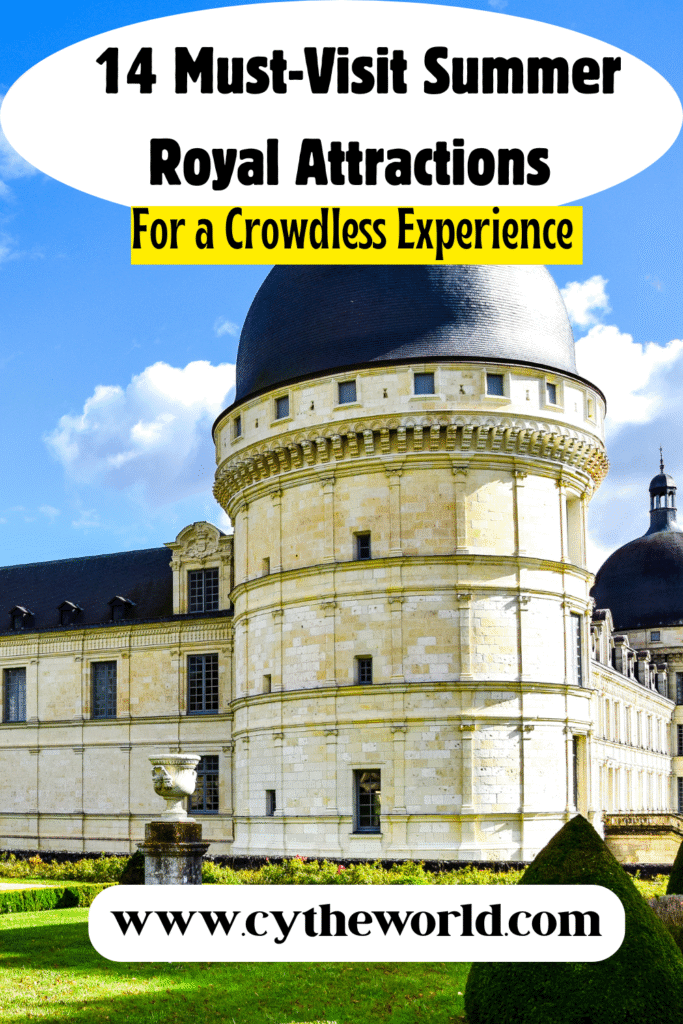
- Château de Chantilly, France
Lastly, no visit to France is complete without a trip to Paris or its surrounding areas. A previous post highlighted other châteaux you can visit outside of Versailles, still within the Île-de-France region. Although Chantilly is not in the Île-de-France region, its distance is comparable to that of the cities, making it the perfect place to escape Paris’s overcrowding, as the royals once did to the Château de Chantilly. The palace is a stunning example of French Renaissance architecture, blending elegance with historical significance. Built in the 16th century and later expanded in the 17th century, the château showcases a unique juxtaposition of styles, featuring a grand central courtyard surrounded by exquisite gardens and sweeping views of the surrounding landscape. Its façade is adorned with intricate stone carvings and ornate windows, while the opulent interiors boast lavishly decorated rooms filled with priceless art and antiques.
Historically, the Château de Chantilly has been a royal residence and a hub for the arts, most notably housing the renowned Condé Museum, which boasts an impressive collection of paintings, manuscripts, and artifacts. The estate’s rich tapestry of events includes the patronage of princes to the arts and the hosting of grand festivities, reflecting its grandeur and cultural significance. One of the key advantages of visiting Château de Chantilly is the opportunity to have a crowdless experience. Chantilly offers a serene atmosphere, allowing visitors to enjoy strolls through its picturesque gardens and take in the beauty of the château without the typical crowds. Horse lovers have an opportunity to ride a horse around the massive royal grounds. Visiting in the summer also means enjoying horse racing. A tour also includes activities like Chantilly whipped cream workshops. A day trip to the château offers everything for a perfect royal experience, complete with fun activities for everyone to enjoy and a tranquil atmosphere. Hence, the Château of Chantilly is an ideal destination for those seeking a serene escape steeped in history and architectural magnificence.

Conclusion
In conclusion, exploring Europe’s hidden royal castles offers a unique opportunity to connect with history while avoiding the bustling crowds of more famous landmarks. These often-overlooked gems not only showcase stunning architecture and rich heritage but also provide a serene escape into the enchanting world of European royalty. As summer beckons travelers to seek meaningful experiences, visiting these majestic sites can lead to unforgettable memories filled with elegance and tranquility. Embrace the charm of these castles and let them transport you to a bygone era, making your European adventure truly captivating and enriching. Trade the long lines of Versailles for ivy-clad towers, echoing halls, and glowing courtyards that tell stories without words. Whether you’re chasing history, scenery, or European summer magic, these castles offer an undiscovered, royal side to your adventures. Bookmark this list for your next crowdless attraction quest and let the journey begin.
Thank you for reading. Like, share, and subscribe to our mailing list for more travel tips.
Until next time,
Happy Summer Adventure!
Xoxo,
Cy